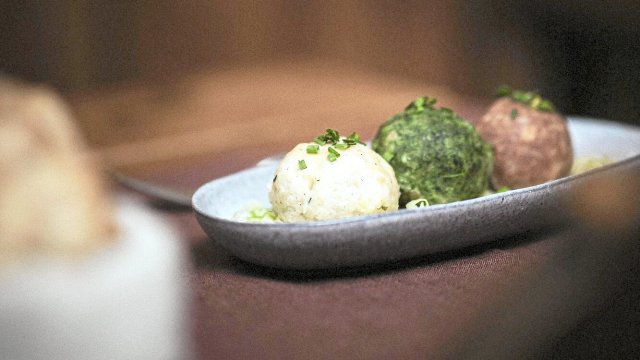South Tyrol | Beautiful view for dumpling fans
Up here, 2,845 meters above sea level, it's all about two things. Two South Tyrolean celebrities who are also known in New York or Sydney: Ötzi and dumplings. Ambitious mountaineers come to the "Schöne Aussicht," a mountain hut high up in the Schnalstal Valley, from where they battle their way ever further into the Ötztal Alps. They cross glaciers, skirt 3,000-meter peaks, and struggle to eventually reach the site where Ötzi was discovered. The others are there to enjoy the legendary dumpling menu. Five courses of bread, eggs, milk, and refined ingredients that are supposed to taste like heaven on earth. And we're already a step closer to heaven.
Paul Grüner, who owns the "Schöne Aussicht," agrees. "I like the spirit up here." Guests are much more relaxed than in the valley, and expectations are lower. "The little things of everyday life are removed in the hut. You can concentrate more on what's important." Grüner should know; after all, he runs a posh hotel in Karthaus, at the entrance to the Schnalstal Valley. You can meet movie stars and the super-rich there. Grüner even convinces a few to visit the "Schöne Aussicht." And lo and behold: even the seemingly complicated ones become more relaxed.
For 40 years, Grüner has commuted between the hotel and the hut, summer and winter. When asked which he prefers, he doesn't answer with words. He taps on the old wood in the hut's living room and smiles. Grüner is a chef, innkeeper, restaurateur, hotelier, but above all, he is the dumpling king. No other has fought so hard in recent decades to preserve the image of this once poor man's food.
In the 1980s, dumplings were still hip and sold like hotcakes. Then came the first dumpling slump, and Grüner came around the corner with his vision: "My plan was to develop a cool, trendy lifestyle food." Bacon gone – replaced by scampi or truffles as sophisticated ingredients. Grüner appointed himself dumpling ambassador, traveling from trade fair to trade fair in an early version of a food truck. He carried his dumpling box with him. At home in the Schnalstal Valley, a group of housewives produced the round things for him, which were then frozen. On Lake Constance, Grüner opened his first "Knödelpoint" with a restaurant and sales outlet. A franchise system was fully developed and in the drawer. But again, a slump on the dumpling front hit, and Grüner abandoned his plans.

The 61-year-old has accepted that dumplings are constantly up and down, like a football team on a yo-yo, sometimes playing in the top league and then having to drop back down to the second tier. No one knows how long this rule has been in place. But scientists are fairly certain about one thing: dumplings were already being eaten in what is now South Tyrol around 900 years ago.
To get a closer look at the evidence, you have to descend from the "Schöne Aussicht" (Beautiful View) to Kurzras. Hop in the car, leave the Schnalstal Valley, and head south. The route takes you to Hocheppan Castle, a popular tourist destination near Bolzano. The climb is short but steep. There's a restaurant at the top, of course, and dumplings, of course, although only the classic ones with cheese or speck.
But we didn't come for the food, we came to see the chapel. Built in 1131 in the Romanesque style, passion flowers entwine around the arched windows. Inside are Byzantine frescoes. They primarily depict the suffering and life of Jesus; at one point, he is depicted as a king. He is lying down and having food handed to him. Directly below him is a woman, a taster. What she's tasting is quite round. Dumplings, in fact.
Critics argue that round bread certainly existed back then. Anyone who doubts the taster's opinion must be content with a legend set in the 15th century: Soldiers stormed a farm in South Tyrol and demanded food. The only supplies were hard bread, eggs, onions, bacon, milk, and flour. The housewife made dough, formed balls, and threw them into hot water.
Dumplings aren't easy to make on the side. This is evident even in the afternoon at the hut. In the kitchen, all the staff are busy for hours preparing the evening's menu. "The dumpling is simple yet difficult. It shouldn't be too fluffy, but also not too hard," says Grüner.

After all, his favorite dish is currently back in the top league. "The zeitgeist is taking us back to our roots, to regional products, to zero-mileage menus. This is making dumplings fully socially acceptable again." Grüner, a tall, powerful man, has to duck his head as he steps through the doorway into the living room. He doesn't wait long for quiet to return, but immediately starts, telling his personal dumpling story and explaining the menu. He ends with the words: "Dumplings are the food of us people in the mountains. And now it's your turn."
The first dumpling has a hearty cheese center, while number two is a delicate truffle specimen. Two small, understated herb dumplings float in the soup course. The main course, the beef, becomes a supporting role. You enjoy a curd cheese and leek dumpling that deserves the title "light and fluffy." For the finale, Grüner, who always lends a hand when things get heated, serves up a chocolate dumpling. The only thing you can say afterward is: "Schnaps." Dumplings are guaranteed to fill you up, even if you've climbed up to the "Schöne Aussicht" (Beautiful View) beforehand.
A glacial lake lies 20 minutes from the cabin. In his younger years, Grüner rented pedal boats there and set up a sailing school. "But the wind never worked out." It remains unclear whether this was a serious business idea or whether Grüner was simply fulfilling his own dream. After all, he finds it most relaxing when the wind blows around his nose. On vacation, he likes to charter a boat in Croatia or elsewhere on the Mediterranean. "Otherwise, all I see all year is rocks and glaciers."
Grüner has even made something out of it. A cosmetics line, in fact. Even as a young man, he observed how glaciers ground down the rocks, leaving behind fine abrasion. "I thought, let's make a scrub out of it." This idea didn't pan out. Today, a cosmetics manufacturer commissioned by Grüner uses the minerals in the rock dust to produce hand cream, day cream, and sunscreen. "Look at me. It keeps you young," jokes Grüner. But maybe it's also the clear air at 2,845 meters and the dumplings. "I could actually eat them every day."
The research was supported by IDM South Tyrol.
nd-aktuell


